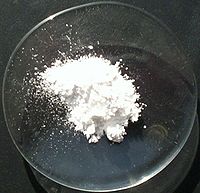
Photo from wikipedia
In this paper, activated aluminas were synthesized directly using cheap precursor via a simple thermal process and short time using no sacrificial templates. The dehydration of gibbsite has been studied… Click to show full abstract
In this paper, activated aluminas were synthesized directly using cheap precursor via a simple thermal process and short time using no sacrificial templates. The dehydration of gibbsite has been studied at different temperatures (350–1150 °C) by flash calcination. The synthesized materials were characterized by X-ray diffraction (XRD), field emission scanning electron microscopy (FE-SEM), and N2 adsorption measurements. According to the obtained results, the temperature appeared to be the key parameter at activation process. The changes of the specific surface area affected on the average pore size because the amounts of pore volume were nearly constant. The powders prepared by the flash calcination method had a monomodal pore distribution with mesopores. FE-SEM images showed particle growth in nanodimensional. The optimum temperature for powder synthesized by flash calcination was 650 °C, which the surface area, pore volume, and average pore size were 262 m2/g, 0.22 cm3/g, and 33 Å, respectively. The synthesized powder had smaller nanoparticles for 650 °C in comparison of other temperatures.
Journal Title: Journal of the Australian Ceramic Society
Year Published: 2017
Link to full text (if available)
Share on Social Media: Sign Up to like & get
recommendations!